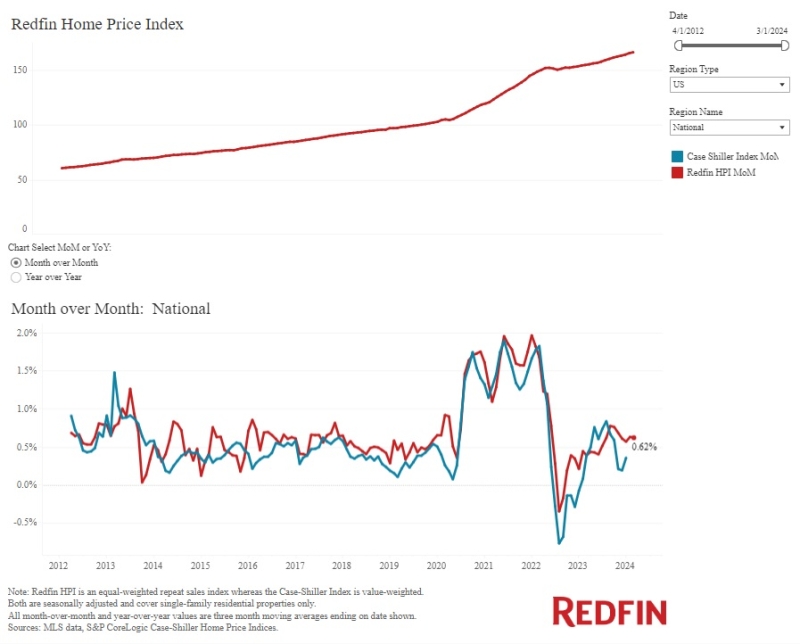Advertisement
Interthinx Q4 fraud risk report finds levels elevated, but unchanged

While the overall Interthinx Mortgage Fraud Risk Index remains elevated but unchanged from the previous quarter’s value of 145 (n = 100), it is worth noting the reversal in a number of trends that have persisted over the last year or longer. It is not yet possible to determine whether these reversals represent normal fluctuations in fraud risk or herald a fundamental shift in long term trends.
► With the addition of several MSAs to the highest risk category, California moved into first place in the Mortgage Fraud Risk Index displacing Nevada, which had topped the rankings over the last five consecutive quarters.
► The indices for both California and Nevada fell slightly from a quarter ago but remain elevated at 222 and 220, respectively. The lowest risk states’ indices increased, indicating a narrowing of the Mortgage Fraud Risk Index range from Q3 2009. This redistribution of fraud risk geographically is in direct contrast to the trend observed between Q3 2008 and Q3 2009.
► The Property Valuation Fraud Risk Index decreased 4% from the previous quarter, the first such decline since Q4 2007. Despite the quarter-on-quarter decrease, this index is up 40% over the last year and up more than 100% from two years ago. Schemes involving short sales, REO inventories, “wholesale” flipping, and refinancing by borrowers whose equity has been impaired by falling real estate values continue to drive this Index.
► The Occupancy Fraud Risk Index rose 16 percent since the last quarter, the first significant increase in the index since Q4 2006. The magnitude of the quarter-on-quarter increase suggests that occupancy fraud risk may become a serious issue going forward, as continuing price declines and “get rich quick” schemes lure investors back into the market and as builders face continuing difficulty in moving unsold inventory.
► The Employment/Income Fraud Risk Index increased three percent from a quarter ago, the first quarter-on-quarter increase since this index peaked in Q3 2007. The index declined by more than 50 percent by Q3 2009, likely due to the elimination of stated and low documentation loan programs, lenders’ increased use of Internal Revenue Service (IRS) data to verify income and to a reduced need for misrepresentation of income as housing generally becomes more affordable. The current quarter-on-quarter increase suggests that employment/income fraud risk may be poised for a rebound.
Mortgage fraud risk hot spots and trends
The national Mortgage Fraud Risk Index remains elevated at 145 (n = 100). This index value is essentially unchanged from both a year ago and from last quarter, as decreases in the first two quarters of 2009 were canceled out by a sharp uptick in the third quarter. Figure 1 shows the distribution of current mortgage fraud risk in MSAs throughout the United States. Of the states that have consistently been well-represented in the “very high risk” category: The number of “very high risk” MSAs has increased in California, Arizona and Michigan, has decreased in Florida, Colorado and Ohio, and has remain unchanged in Nevada. The increase in the number of “very high risk” MSAs in California means that nearly all of the state’s MSAs are now included in this category. Of the MSAs in states that were represented in the “very high risk category” for the first time in the last quarter, Charleston South Carolina, Portland Oregon, and Minneapolis-St. Paul Minnesota moved to lower risk categories. However, Bend Oregon and Washington DC remained in the highest risk category, and the Winchester, Virginia metro adjoining the Washington DC metro is a new addition to the “very high risk” category.
Table 1 shows the Mortgage Fraud Risk Index for the 10 MSAs with the highest mortgage fraud risk. Seven of these are located in California, and as with past quarters, California’s riskiest MSAs are concentrated in the inland regions of the state. This quarter, Modesto ranks worst nationally with an Index value of 303, compared to the national value of 145. Stockton, the most risky MSA the past two quarters, moves into second place with an index of 297. Cape Coral-Fort Myers Florida, Phoenix Arizona and Las Vegas Nevada complete the top 10. With the exception of Las Vegas, which has seen a 13 percent decrease in its index over the last year, all the other MSAs in the top 10 have seen increases of greater than 20 percent.
Geographic fraud risk migration
Mortgage fraud migrates geographically to take advantage of local market conditions. This section examines the geographic migration of mortgage fraud risk within the 50 States and the District of Columbia.
Figure 2 depicts the Fraud Risk Index for the individual states, with the 10 highest risk states shown in red. California has the highest mortgage fraud risk, with an Index value of 222. Nevada, which had the highest index for the previous five consecutive quarters, drops to second place with an index of 220, and is closely followed by Arizona with an index of 211. Florida remains in fourth place with an index of 179, while Colorado is in fifth place at 153. The top 10 is rounded out by the capital region (Maryland, Washington DC and northern Virginia), and the hard-hit industrial states of Michigan and Ohio. The ten states with the lowest risk, shown in green, are West Virginia, Maine, Kansas, South Dakota, Montana, Wyoming, Alabama, Vermont, Mississippi and Iowa. The five lowest risk states have Index values of less than half the national value.
Figure 3 shows the change in the Mortgage Fraud Risk Index from the last quarter. The indices for both California and Nevada actually fell by 10 and 31 points, respectively, from a quarter ago, but remain highly elevated. The much larger decrease in Nevada accounts for California moving to first place in the rankings. While the indices for the seven riskiest states all decreased from the last quarter, the indices for all ten of the least risky states increased. This represents a narrowing of fraud risk across the states, which is reflected in the decline in the Mortgage Fraud Risk Index spread from 215 points in Q3 2009 to 167 points in the current quarter. This is in direct contrast to the expansion of this index range observed between Q3 2008, when the range was 100, and Q3 2009, when it reached 215.
California’s movement into the top spot in the rankings is significant because of the sheer volume of loans issued in this state and the magnitude of the potential economic losses to lenders. In the past, numerous regions of relatively low risk counterbalanced and moderated California’s overall fraud risk. However, as shown in Figure 4, the number of high risk counties in California has increased significantly, and fraud risk has spread dramatically throughout the state over the last year. In Q3 2008, the state’s fraud risk was “relatively moderate”, with no counties having an Index value exceeding 200. The relentless increase and spread of mortgage fraud risk between Q3 2008 and Q3 2009, starting in the Central Valley region, was described in the Interthinx Q3 2009 Fraud Risk report and continues unabated. Despite the drop in the state’s overall index from 230 to 220, the number of counties with very high mortgage fraud risk has increased from the last quarter, with four additional counties (Santa Barbara, Madera, Yuba and Sutter) breaching the 200 mark. Only one county that was previously above that benchmark dropped below 200 (Yolo).
Type-specific mortgage fraud risk hot spots and trends
Interthinx tracks four type-specific fraud risk indices: Property Valuation, Identity, Occupancy and Employment/Income. This section examines the hot spots and trends for these type-specific fraud risks.
Property Valuation Fraud Risk Index
Property Valuation Fraud is perpetrated by manipulating property value to create “equity” which is then extracted from loan proceeds by various means. Table 2 shows that the four MSAs with the highest property valuation fraud risk are located in California, with Cape Coral-Fort Myers Florida rounding out the top 5. These MSAs have extremely high Index values in excess of 600, and their Property Valuation Fraud Risk Index values have increased 150 percent or more over the last year. Although the national index decreased 3.5 percent from the last quarter--the first quarter-on-quarter decrease since Q4 2007--it has increased by 40 percent over the last year, continuing a strong trend that began in Q4 2006 when this index bottomed out as housing prices reached their peak.
Figure 5 illustrates that the sharp rise in the property valuation fraud risk index (dark blue) over the last two years offset decreases in the occupancy and employment/income fraud risk indices to become the major driver of the overall fraud risk index. This is also shown in Figure 6 by the strong correlation between the overall risk levels and property valuation fraud risk for MSAs throughout the United States.
It is no surprise that the states with the highest risk for property valuation fraud are also the states with the highest levels of “underwater” borrowers and foreclosure activity, as shown in Figures 7 and 8. Property valuation fraud risk in these geographies can be expected to continue at extremely high levels as “shadow” foreclosure inventories are released into the market, further depressing prices and encouraging additional walkaways.
Employment/Income Fraud Risk Index
Employment/Income Fraud occurs when an applicant’s income is misrepresented in order to qualify for a loan. Table 3 shows that while the Employment/Income Fraud Risk Index is down 29 percent over the last year, it increased 3.4 percent over the last quarter--the first increase since the Index peaked in Q3 2007 at 197. It is too soon to tell whether this uptick portends a rebound in employment/income fraud risk or whether it reflects a temporary “blip” associated with schemes involving the Federal First-time Homebuyer Tax Credit Program due to expire on April 30, 2010.
Index risk levels for the top five MSAs, four of which are in California, increased more than 20% from the last quarter. In contrast to the overall fraud risk in California, which is concentrated in the inland regions, employment/income fraud risk is greatest in MSAs along the coast where prices have not declined as much. Exaggerated employment/income occurs most often in high-cost MSAs where borrowers have difficulty meeting lenders’ debt-to-income criteria. Reading PA, which also has a very high Occupancy Fraud Risk Index, rounds out this group.
Occupancy Fraud Risk Index
Occupancy Fraud is perpetrated by investors who falsely claim the intent to occupy the purchased property so as to obtain a mortgage with lower down payments and/or interest rates. The Occupancy Fraud Risk Index jumped 16 percent from last quarter after decreasing steadily since the Index peaked in Q4 2006 at 187. Following the very slight increase recorded between Q2 and Q3 2009, the Interthinx projection that this Index was poised for a rebound appears to be confirmed. Investor demand, stoked by plentiful inventories and the expected release of “shadow” inventory by lenders in 2010, is likely to propel this Index higher for the foreseeable future.
Table 4 identifies the top five MSAs in the Occupancy Fraud Risk Index. Reading, PA, with a nearly 400 percent increase, has surged to the top. The metros of Miami, currently in 2nd place, and Detroit, currently in 4th place, have been in the top five for three consecutive quarters. The California metros of Modesto and Fresno round out the table.
Identity Fraud Risk Index
Identity fraud is frequently used in mortgage fraud schemes in order to hide the identity of the perpetrators and/or to obtain a credit profile that will meet lender guidelines. The Identity Fraud Risk Index has remained relatively constant over the last two years, declining two percent from the previous quarter and four percent from a year ago. Table 5 shows that the top five MSAs are concentrated in the Southeast. The Florida metros of Naples-Marco Island and Miami bracket this group, which also includes Jackson Mississippi, Nashville Tennessee and Augusta Georgia. Over the last year, all five of these MSAs have experienced increases of greater than 50 percent.
Extended forecast
The Interthinx Fraud Risk Indices have proven to be a leading indicator of foreclosure activity. Therefore, the regions that currently have high Fraud Risk Indices are likely to have high foreclosure rates going forward, particularly if housing prices continue on their downward trajectory and if there is no significant improvement in general economic conditions. Based on the Fraud Risk Indices, regions that bear close scrutiny going forward include:
► California, which rose by 61 to the highest Index of 222, experienced the largest one-year increase. Seven of the ten highest risk MSAs are located in California, and many of its counties have index values greater than 200.
► Nevada, which despite losing the number one spot, still has a Mortgage Fraud Risk Index of 220.
► Arizona, which also has an Index value over 200.
► Florida, which has the fourth highest Index and contains a number of very high risk MSAs: Cape Coral-Fort Myers (in the top 5 MSAs for both mortgage fraud risk and property valuation fraud risk), Miami-Fort Lauderdale-Pompano Beach (in the top 5 MSAs for both identity and occupancy fraud risk), and Naples-Marco Island, (the highest identity fraud risk nationwide).
Interthinx also projects that while interest rates remain low, the predominant fraud type will continue to be related to property valuation as speculative investors and “flipping” return to the market, and as consumers attempt to refinance their mortgages despite reduced equity in their properties. Interthinx also expects a rebound in Occupancy fraud, particularly in light of investor demand, fueled by ample inventories and the expected release of “shadow” inventory. Interthinx expects that the Fraud Risk Index will continue to rise through 2011 as a wave of ARMs, the majority of which contain negative amortization features, recast for the first time.
For more information, visit www.interthinx.com.
About the author





